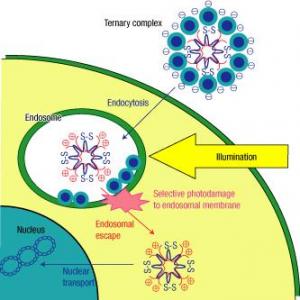1) Virus-induced gene silencing


病毒诱导基因沉默
1.
Virus-induced gene silencing(VIGS) is a recently developed technique of gene transcript suppression for characterizing gene functions of plants in reverse genetics,which involves a virus delivery vector carrying a short sequence of targeted gene to infect a young plant,and in a few weeks natural defense mechanisms of the plant result in silencing of the targeted gene.
病毒诱导基因沉默(Virus-induced gene silencing,VIGS)技术是指带一段靶基因序列的VIGS重组病毒侵染植物、引起植物同源基因沉默与表型变异,进而通过表型变异进行基因功能分析的方法,是近年发展起来的从反向遗传学方向快速鉴定植物基因功能的技术,是转录后基因沉默机制的一种表现。
4) virus-induced gene silencing


病毒诱导的基因沉默
1.
The term virus-induced gene silencing (VIGS) was first used to describe the phenomenon of recovery from virus infection, a natural plant antiviral mechanism, which recently has been exploited as a genetic technique involving recombinant viruses with a target gene fragment insert to knock down expression of endogenous target genes, and thereby analyse gene functions.
病毒诱导的基因沉默"(virus-induced gene silencing,VIGS)一词最早用于描述被病毒侵染的植物的恢复"现象,是一种植物抗病毒侵染的自然机制,现在已被开发成通过插入目的基因片段的重组病毒抑制植物内源基因表达的遗传技术,用于基因功能分析。
2.
The results showed that gusA could be silenced in leaves,flowers,fruits,branches,stems and the points between branch and stem of tomato by virus-induced gene silencing.
病毒诱导的基因沉默(VIGS)是植物基因功能研究的新技术。
5) virus induced gene silencing


病毒诱导的基因沉默
1.
For virus induced gene silencing (VIGS), it is induced by infecting a plant with a plant virus that has had its genome modified to include a sequence identical to that in RNA transcribed from the host gene to be silenced.
病毒诱导的基因沉默 (virusinducedgenesilencing ,VIGS)是指携带植物功能基因cDNA的病毒在侵染植物体后 ,可诱导植物发生基因沉默而出现表型突变 ,进而可以研究该目的基因功能 。
6) virus induced gene silencing(VIGS)


病毒诱导的基因沉默(VIGS)
补充资料:光诱导型基因传递系统

光诱导型基因传递系统
东京大学(the university of tokyo)研究者的最新报道指出,他们解决了在基因治疗中的最大挑战—将dna安全、有效地转入细胞。他们开发了一种光诱导的基因传递系统(gene delivery system):将dna分子和光敏感化合物组装进一个简单的结构中,进而使实验操作对细胞的毒害降低到最小。
类似dna的大分子进入细胞的主要方法是通过胞吞作用(endocytosis),细胞外膜内陷将化合物单独隔离在一个称作内涵体(endosome)的区室中。光敏分子(photosensitive molecule)在接受光激发的时候帮助dna分子破膜而出。在dna周围包被上这种分子,使得研究者对细胞内其他细胞器和膜结构的破坏降低到最小。
说明:补充资料仅用于学习参考,请勿用于其它任何用途。